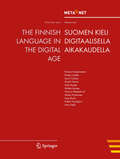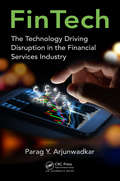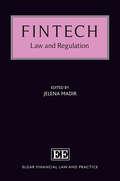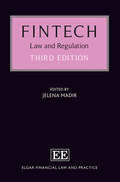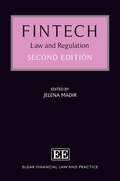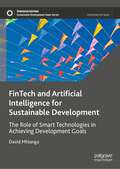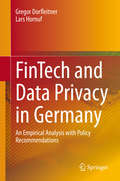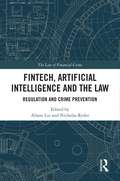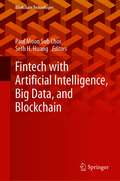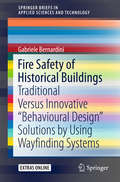- Table View
- List View
Finitely Generated Abelian Groups and Similarity of Matrices over a Field (Springer Undergraduate Mathematics Series)
by Christopher NormanAt first sight, finitely generated abelian groups and canonical forms of matrices appear to have little in common. However, reduction to Smith normal form, named after its originator H.J.S.Smith in 1861, is a matrix version of the Euclidean algorithm and is exactly what the theory requires in both cases. Starting with matrices over the integers, Part 1 of this book provides a measured introduction to such groups: two finitely generated abelian groups are isomorphic if and only if their invariant factor sequences are identical. The analogous theory of matrix similarity over a field is then developed in Part 2 starting with matrices having polynomial entries: two matrices over a field are similar if and only if their rational canonical forms are equal. Under certain conditions each matrix is similar to a diagonal or nearly diagonal matrix, namely its Jordan form. The reader is assumed to be familiar with the elementary properties of rings and fields. Also a knowledge of abstract linear algebra including vector spaces, linear mappings, matrices, bases and dimension is essential, although much of the theory is covered in the text but from a more general standpoint: the role of vector spaces is widened to modules over commutative rings. Based on a lecture course taught by the author for nearly thirty years, the book emphasises algorithmic techniques and features numerous worked examples and exercises with solutions. The early chapters form an ideal second course in algebra for second and third year undergraduates. The later chapters, which cover closely related topics, e.g. field extensions, endomorphism rings, automorphism groups, and variants of the canonical forms, will appeal to more advanced students. The book is a bridge between linear and abstract algebra.
Finitely Supported Mathematics: An Introduction
by Andrei Alexandru Gabriel CiobanuIn this book the authors present an alternative set theory dealing with a more relaxed notion of infiniteness, called finitely supported mathematics (FSM). It has strong connections to the Fraenkel-Mostowski (FM) permutative model of Zermelo-Fraenkel (ZF) set theory with atoms and to the theory of (generalized) nominal sets. More exactly, FSM is ZF mathematics rephrased in terms of finitely supported structures, where the set of atoms is infinite (not necessarily countable as for nominal sets). In FSM, 'sets' are replaced either by `invariant sets' (sets endowed with some group actions satisfying a finite support requirement) or by `finitely supported sets' (finitely supported elements in the powerset of an invariant set). It is a theory of `invariant algebraic structures' in which infinite algebraic structures are characterized by using their finite supports. After explaining the motivation for using invariant sets in the experimental sciences as well as the connections with the nominal approach, admissible sets and Gandy machines (Chapter 1), the authors present in Chapter 2 the basics of invariant sets and show that the principles of constructing FSM have historical roots both in the definition of Tarski `logical notions' and in the Erlangen Program of Klein for the classification of various geometries according to invariants under suitable groups of transformations. Furthermore, the consistency of various choice principles is analyzed in FSM. Chapter 3 examines whether it is possible to obtain valid results by replacing the notion of infinite sets with the notion of invariant sets in the classical ZF results. The authors present techniques for reformulating ZF properties of algebraic structures in FSM. In Chapter 4 they generalize FM set theory by providing a new set of axioms inspired by the theory of amorphous sets, and so defining the extended Fraenkel-Mostowski (EFM) set theory. In Chapter 5 they define FSM semantics for certain process calculi (e.g., fusion calculus), and emphasize the links to the nominal techniques used in computer science. They demonstrate a complete equivalence between the new FSM semantics (defined by using binding operators instead of side conditions for presenting the transition rules) and the known semantics of these process calculi. The book is useful for researchers and graduate students in computer science and mathematics, particularly those engaged with logic and set theory.
Finiteness and Regularity in Semigroups and Formal Languages (Monographs in Theoretical Computer Science. An EATCS Series)
by Aldo de Luca Stefano VarricchioThis is a rigorous and self-contained monograph on a central topic in theoretical computer science. For the first time in book form, original results from the last ten years are presented, some previously unpublished, using combinatorial and algebraic methods. These are mainly based on combinatorics on words and especially on the theory of "unavoidable regularities." Researchers will find important new results on semigroups and formal languages, as well as various applications for these methods.
The Finnish Language in the Digital Age (White Paper Series)
by Georg Rehm Hans UszkoreitThis white paper is part of a series that promotes knowledge about language technology and its potential. It addresses educators, journalists, politicians, language communities and others. The availability and use of language technology in Europe varies between languages. Consequently, the actions that are required to further support research and development of language technologies also differ for each language. The required actions depend on many factors, such as the complexity of a given language and the size of its community. META-NET, a Network of Excellence funded by the European Commission, has conducted an analysis of current language resources and technologies. This analysis focused on the 23 official European languages as well as other important national and regional languages in Europe. The results of this analysis suggest that there are many significant research gaps for each language. A more detailed expert analysis and assessment of the current situation will help maximise the impact of additional research and minimize any risks. META-NET consists of 54 research centres from 33 countries that are working with stakeholders from commercial businesses, government agencies, industry, research organisations, software companies, technology providers and European universities. Together, they are creating a common technology vision while developing a strategic research agenda that shows how language technology applications can address any research gaps by 2020.
FinTech: The Technology Driving Disruption in the Financial Services Industry
by Parag Y ArjunwadkarEverything that we know about the world of finance is changing before us. Innovation is happening constantly, despite the protests of the traditional financial industry. With all the new technology that we have today, it is almost mind-blowing to think about the kind of technology that we will have in another ten years or so. The change is going to keep coming, the only thing we can do is get on board with it. This book introduces the basics of FinTech and equips readers with the knowledge to get on the cutting edge of age we live in today.
FinTech: The Technology Driving Disruption in the Financial Services Industry
by Parag Y ArjunwadkarEverything that we know about the world of finance is changing before us. Innovation is happening constantly, despite the protests of the traditional financial industry. With all the new technology that we have today, it is almost mind-blowing to think about the kind of technology that we will have in another ten years or so. The change is going to keep coming, the only thing we can do is get on board with it. This book introduces the basics of FinTech and equips readers with the knowledge to get on the cutting edge of age we live in today.
FinTech: Law and Regulation (Elgar Financial Law and Practice series)
by Jelena MadirFinTech has developed rapidly in recent years, and with these developments new challenges arise, particularly for regulators: how do you apply current law to these ever-changing concepts in a world of continual technological advancement? Key features include: • Insight from FinTech specialists from 10 countries, unpicking the legal and regulatory issues across banking, payments and fundraising • Detailed clarification on developments in alternative funding platforms, cryptoassets, initial coin offerings, blockchain and smart contracts • Discussion of innovative solutions for regulators including how to combat the challenges of patenting FinTech inventions and regulating robo-advisors • Guidance for law firms on meeting the challenges presented by the speed of technological innovation and new entrants in the financial sector. Offering a thorough overview of the sector for practical use, FinTech: Law and Regulation will be an invaluable guide for in-house lawyers as well as law firms looking for an overview of legal and regulatory issues in FinTech. It will also be an essential text for those looking to understand the breadth of the sector, as well as the key legal and regulatory issues.
FinTech: Law and Regulation, 3rd edition (Elgar Financial Law and Practice series)
by Jelena MadirThis fully revised and updated third edition provides a practical examination of legal and regulatory issues in FinTech, a sector whose rapid rise in recent years has produced opportunities for innovation but has also raised new challenges. Featuring insights from over 40 experts from 10 countries, this book analyses the statutory aspects of technology-enabled developments in banking and considers the impact these changes will have on the legal profession.Key Features:Three new chapters covering AI in the Financial Sector, Bank-Fintech Partnerships and Embedded Payments, and a Comparison of the Regulation of Cryptoasset Activities in Europe and the United StatesExamination of potential blockchain and artificial intelligence applications in the financial services industryExploration of guidelines on data protection, payments, cybersecurity, central bank digital currencies, anti-money laundering, tokenisation and blockchainAnalysis of the main regulatory and compliance issues surrounding FinTech developments, from patenting challenges to innovative solutions, including regulatory sandboxesDissection of the EU's Regulation on Markets in Crypto-assets and DLT Pilot Regime, the US's Executive Order on Ensuring Responsible Development of Digital Assets, the UK's Financial Services and Markets ActConsidering the benefits and risks of new types of financial technologies, this book will prove an invaluable guide for in-house and private lawyers interested in a comprehensive legal overview of the FinTech sector. It will also appeal to students and scholars of financial law, banking, and economics.
FinTech: Law and Regulation (Elgar Financial Law and Practice series)
This fully updated and revised second edition provides a practical examination of the opportunities and challenges presented by the rapid development of FinTech in recent years, particularly for regulators, who must decide how to apply current law to ever-changing concepts driven by continually advancing technologies. It addresses new legislative guidance on the treatment of cryptoassets and smart contracts, the European Commission’s Digital Finance Strategy and FinTech Action Plan, as well as analysing significant recent case law.Key features of the second edition include:Discussion of the impact of Brexit and the Covid-19 pandemic on the development and adoption of FinTech productsDetailed treatment of a broad spectrum of legal and regulatory issues in the FinTech sector, featuring insights from 33 experts from 10 countriesExamination of potential blockchain applications in the financial services industry, with a focus on smart contracts and regulatory challenges to widespread adoptionAnalysis of the key legal, regulatory and compliance issues surrounding FinTech developments in banking, payments and fundraising, from patents and robo-advice to novel solutions for supporting innovation such as regulatory sandboxes.Offering a thorough guide to the sector for practical use, this book will be invaluable for in-house lawyers as well as law firms looking for an overview of the legal and regulatory landscape of FinTech. It will also be an essential text for academics and students looking to understand the key issues in the field, as well as those interested in perspectives across the breadth of the sector.
FinTech and Artificial Intelligence for Sustainable Development: The Role of Smart Technologies in Achieving Development Goals (Sustainable Development Goals Series)
by David MhlangaThis book investigates how smart technologies can play a crucial role in the achievement of the UN Sustainable Development Goals. Focusing on FinTech as well as artificial intelligence, the author demonstrates how one of the most effective strategies for accelerating progress toward global development goals is to make use of emerging technologies to broaden and deepen the scope of action. The first part of the book offers a historical perspective on sustainable development, financial technology and the emergence of the Fourth Industrial Revolution, while the second part looks in-depth at new technologies that can contribute to the realization of the SDGs. The power of AI to reduce poverty and increase food security, the implications of digital innovations for education, the impact of AI on clean transport, the role of FinTech in mitigating climate change, and ways in which AI can aid financial inclusion are all discussed.
Fintech and Cryptocurrency
by Mohd Naved V. Ajantha Devi Aditya Kumar GuptaFINTECH and CRYPTOCURRENCY Dive into the world of fintech and cryptocurrency through the engaging perspectives of this diverse group of authors and uncover the intricate connections between technology, finance, and cryptocurrency that make this a must-have for anyone intrigued by the future of digital society. Digital currencies, decentralization of money, and the growth of new technologies like blockchain, the Internet of Things, and machine learning have produced new opportunities and difficulties for banking and finance, as well as users of these services in electronic commerce. New banking and finance technologies may improve operational efficiency, risk management, compliance, and client pleasure, but they can decrease barriers and introduce new concerns, such as cybersecurity risk. Cryptocurrencies with smart contracts for payments and trading, as well as AI systems with adaptive algorithms that allow picture and speech recognition, expert judgement, group categorization, and forecasting in a variety of fields, are instances of increased automation. Simultaneously, the potentials pose risks and raise regulatory concerns. The rise of blockchain technology and its widespread use have had a significant impact on the operation and management of digital systems. At the same time, researchers and practitioners have paid close attention to digital finance. Blockchain’s first applications were limited to the production of digital currency, but it has now been expanded to include financial and commercial applications. Innovative digital finance has had a huge impact on business and society since it has been extensively adopted by businesses and consumers. As a result, the goal of this edited book is to expand and deepen our knowledge of the business possibilities of novel blockchain and digital financial applications.
Fintech and Cryptocurrency
by Mohd Naved V. Ajantha Devi Aditya Kumar GuptaFINTECH and CRYPTOCURRENCY Dive into the world of fintech and cryptocurrency through the engaging perspectives of this diverse group of authors and uncover the intricate connections between technology, finance, and cryptocurrency that make this a must-have for anyone intrigued by the future of digital society. Digital currencies, decentralization of money, and the growth of new technologies like blockchain, the Internet of Things, and machine learning have produced new opportunities and difficulties for banking and finance, as well as users of these services in electronic commerce. New banking and finance technologies may improve operational efficiency, risk management, compliance, and client pleasure, but they can decrease barriers and introduce new concerns, such as cybersecurity risk. Cryptocurrencies with smart contracts for payments and trading, as well as AI systems with adaptive algorithms that allow picture and speech recognition, expert judgement, group categorization, and forecasting in a variety of fields, are instances of increased automation. Simultaneously, the potentials pose risks and raise regulatory concerns. The rise of blockchain technology and its widespread use have had a significant impact on the operation and management of digital systems. At the same time, researchers and practitioners have paid close attention to digital finance. Blockchain’s first applications were limited to the production of digital currency, but it has now been expanded to include financial and commercial applications. Innovative digital finance has had a huge impact on business and society since it has been extensively adopted by businesses and consumers. As a result, the goal of this edited book is to expand and deepen our knowledge of the business possibilities of novel blockchain and digital financial applications.
FinTech and Data Privacy in Germany: An Empirical Analysis with Policy Recommendations
by Gregor Dorfleitner Lars HornufThis book examines the FinTech revolution from a data privacy perspective. It analyzes key players on the FinTech market and the developments in various market segments. Particular attention is paid to an empirical analysis of the privacy statements of 505 German FinTech firms and how they were adapted after the General Data Protection Regulation (GDPR) entered into effect in May 2018. The analysis also includes 38 expert interviews with relevant stakeholders from supervisory and regulatory authorities, the financial and FinTech industry, leading consulting firms and consumer protection agencies. By adopting this approach, the book identifies key regulatory needs, offers a valuable asset for practitioners and academics alike, and shares intriguing insights for lawyers, economists and everyone interested in FinTech and data privacy.
FinTech, Artificial Intelligence and the Law: Regulation and Crime Prevention (The Law of Financial Crime)
by Alison Lui Nicholas RyderThis collection critically explores the use of financial technology (FinTech) and artificial intelligence (AI) in the financial sector and discusses effective regulation and the prevention of crime. Focusing on crypto-assets, InsureTech and the digitisation of financial dispute resolution, the book examines the strategic and ethical aspects of incorporating AI into the financial sector. The volume adopts a comparative legal approach to: critically evaluate the strategic and ethical benefits and challenges of AI in the financial sector; critically analyse the role, values and challenges of FinTech in society; make recommendations on protecting vulnerable customers without restricting financial innovation; and to make recommendations on effective regulation and prevention of crime in these areas. The book will be of interest to teachers and students of banking and financial regulation related modules, researchers in computer science, corporate governance, and business and economics. It will also be a valuable resource for policy makers including government departments, law enforcement agencies, financial regulatory agencies, people employed within the financial services sector, and professional services such as law, and technology.
FinTech, Artificial Intelligence and the Law: Regulation and Crime Prevention (The Law of Financial Crime)
by Alison Lui Nicholas RyderThis collection critically explores the use of financial technology (FinTech) and artificial intelligence (AI) in the financial sector and discusses effective regulation and the prevention of crime. Focusing on crypto-assets, InsureTech and the digitisation of financial dispute resolution, the book examines the strategic and ethical aspects of incorporating AI into the financial sector. The volume adopts a comparative legal approach to: critically evaluate the strategic and ethical benefits and challenges of AI in the financial sector; critically analyse the role, values and challenges of FinTech in society; make recommendations on protecting vulnerable customers without restricting financial innovation; and to make recommendations on effective regulation and prevention of crime in these areas. The book will be of interest to teachers and students of banking and financial regulation related modules, researchers in computer science, corporate governance, and business and economics. It will also be a valuable resource for policy makers including government departments, law enforcement agencies, financial regulatory agencies, people employed within the financial services sector, and professional services such as law, and technology.
Fintech for ESG and the Circular Economy
by Prasenjit Chatterjee Vinay Kandpal Ernesto Santibanez Gonzalez Peterson OziliThis book showcases research, theoretical, and validated work associated with digital finance to enhance the quality of a more sustainable environment. The primary objective of Fintech for ESG and the Circular Economy is to evaluate how fintech advancements and sustainable practices effectively drive transformative and sustainable change. It aims to motivate individuals with ideas and discussions to promote financial technology and foster creativity for a more sustainable and equitable future. The book delves into the intersection of technology and sustainability, offering insights into how big data, machine learning, and blockchain technology are transforming ESG practices and the circular economy. It highlights the potential of FinTech to drive sustainable finance, explores the current role of cyber ecosystems and digital currencies in sustainable finance, and examines the intricate legal landscape surrounding green finance in India. The book also discusses the influence of ESG factors on financial decision-making and the integration of sustainability metrics into financial analysis, supported by examples of how companies and investors are adopting these practices. Additionally, the book explores the role of financial institutions in enabling crowdfunding platforms, particularly in African markets, and provides case studies that demonstrate their impact on financial inclusion and entrepreneurship. It also analyzes the legal implications of blockchain and smart contracts within FinTech, the convergence of digital business models with ESG principles, and the role of digital currencies in promoting financial inclusion and sustainable economic growth, particularly in India. The book concludes with an exploration of tokenomics and its potential to incentivize sustainable behaviors, and examines how digital finance innovations in Tanzania are improving financial inclusion by overcoming barriers to financial services for the unbanked population. Audience This book will be of interest to scholars, researchers, academicians, and students of commerce, banking, finance, sustainability, and financial technology. This book is helpful for business professionals, researchers, and technical industry workers in finance and artificial intelligence.
FinTech in Germany
by Gregor Dorfleitner Lars Hornuf Matthias Schmitt Martina WeberThis book focuses on market developments of crowdfunding, crowdinvesting, crowdlending, social trading, robo-advice, personal financial management, online payment and mobile payment in Germany. FinTech companies are an important driver of innovation in the financial industry. By making financial transactions more user-friendly and transparent, these firms potentially contribute to financial stability and economic growth. The authors define and categorize the different market segments that have emerged. They further provide an assessment of current market volumes and make forecasts for the next 5, 10 and 20 years. Particular attention is given to the empirical findings resulting from scholarly research. Furthermore, the authors evaluate how the German FinTech market ranks relative to international standards. This book will appeal to finance and entrepreneurship researchers as well as practitioners from banking and tech industries.“This book offers a fresh and fascinating look at the FinTech market. The authors provide a rigorous economic analysis of the FinTech market in Germany and offer many insights that are of interest to practitioners, academics, and policymakers alike.”–Professor Douglas Cumming, Schulich School of Business“Germany is one of the fastest growing FinTech markets in Europe. This book not only provides a comprehensive and systematic overview on the developments and actors, but undertakes a visionary outlook on the forthcoming decades based on scientific methods.”–Dr. Thomas Puschmann, Head of Swiss FinTech Innovation Lab
Fintech with Artificial Intelligence, Big Data, and Blockchain (Blockchain Technologies)
by Paul Moon Sub Choi Seth H. HuangThis book introduces readers to recent advancements in financial technologies. The contents cover some of the state-of-the-art fields in financial technology, practice, and research associated with artificial intelligence, big data, and blockchain—all of which are transforming the nature of how products and services are designed and delivered, making less adaptable institutions fast become obsolete. The book provides the fundamental framework, research insights, and empirical evidence in the efficacy of these new technologies, employing practical and academic approaches to help professionals and academics reach innovative solutions and grow competitive strengths.
Fire Detection in Warehouse Facilities (SpringerBriefs in Fire)
by Joshua Dinaburg Daniel T. GottukAutomatic sprinklers systems are the primary fire protection system in warehouse and storage facilities. The effectiveness of this strategy has come into question due to the challenges presented by modern warehouse facilities, including increased storage heights and areas, automated storage retrieval systems (ASRS), limitations on water supplies, and changes in firefighting strategies. The application of fire detection devices used to provide early warning and notification of incipient warehouse fire events is being considered as a component of modern warehouse fire protection. Fire Detection in Warehouse Facilities provides technical information to aid in the development of guidelines and standards for the use of fire detection technologies for modern warehouse fire protection. The authors share their thorough literature review, analyze characteristic fire hazards for modern warehouse facilities, and identify information gaps in the field. The book concludes with recommendations for the development of guidelines and standards for the use of detection technologies in warehouse fire protection design, including a research plan for implementation. This book is intended for practitioners seeking an understanding of the issues surrounding warehouse design and fire protection. The book will also prove valuable for fire hazard researchers and those involved with fire department response, applicable detection systems, and fire growth suppression.
Fire Flow Water Consumption in Sprinklered and Unsprinklered Buildings: An Assessment of Community Impacts (SpringerBriefs in Fire)
by Code Consultants, Inc.Fire Flow Water Consumption in Sprinklered and Unsprinklered Buildings offers a detailed analysis for calculating the fire water demand required in buildings with existing and non-existant sprinkler systems. The installation of automatic sprinkler systems can significantly reduce the amount of water needed during a fire, but it requires water for commissioning, inspection, testing, and maintenance (CITM). This book provides an estimate of fire water used under both fire conditions, including CITM, to allow communities to develop fire water fees for both sprinklered and unsprinklered buildings that are proportional to the anticipated fire water usage. The types of buildings analyzed include residential (family dwellings as well as those up to four stories in height), business, assembly, institutional, mercantile, and storage facilities. Water volume was studied using guidelines from the International Code Council, the National Fire Protection Association, and the Insurance Services Office. Fire Flow Water Consumption in Sprinklered and Unsprinklered Buildings is intended for practitioners as a tool for analyzing water consumption in fire situations and for providing them with key information on the best types of water systems in a variety of buildings. Researchers working in building planning and safety will also find the book valuable.
Fire Safety Challenges of Green Buildings (SpringerBriefs in Fire)
by Brian Meacham Brandon Poole Juan Echeverria Raymond ChengEnvironmental concerns and advances in architectural technologies have lead to a greater number of green buildings or buildings with green, eco-friendly elements. However, from a practical standpoint, there is no incident reporting system in the world that tracks data on fire incidents in green buildings. Fire safety objectives are not explicitly considered in most green rating schemes, and green design features have been associated with photovoltaic panels and roof materials, lightweight timber frame buildings, and combustible insulation materials. Fire Safety Challenges of Green Buildings is the result of an extensive global literature review that sought to identify issues related to green building elements or features and ways to ensure those issues are tracked for future improvement. The book identifies actual incidents of fires in green buildings or involving green building elements, points out issues with green building elements that would increase fire risk, clarifies reports and studies that address ways to reduce fire risk in green design elements, and compares research studies that explicitly incorporate fire safety into green building design. The authors also pinpoint gaps and specific research needs associated with understanding and addressing fire risk and hazards with green building design. Using their data, the authors developed a set of matrices relating these green attributes and potential fire hazards. With these comprehensive tools, potential mitigation strategies for addressing the relative increase in fire risk or hazard associated with the green building elements and features have been identified. Fire Safety Challenges of Green Buildings is intended for practitioners as a tool for analyzing building safety issues in green architecture and developing methods for tracking data related to green design elements and their potential hazards. Researchers working in a related field will also find the book valuable.
Fire Safety of Historical Buildings: Traditional Versus Innovative “Behavioural Design” Solutions by Using Wayfinding Systems (SpringerBriefs in Applied Sciences and Technology)
by Gabriele BernardiniThis book applies a behavioral point of view to individuals’ fire safety in historic buildings. It outlines theoretical and operative issues, based on recent studies and international guidelines.Firstly, critical issues for Building Heritage fire safety are widely discussed, by including the modelling of human factor and man-environment-fire interference in these architectural spaces. A significant part of the book includes a discussion on emergency modeling and simulation. A source code for representing the fire evacuation process (including man-evacuation facilities interactions) is offered to the reader.Methods for effectiveness assessment of risk-reducing solutions are provided and tested in a case-study. Being a structured approach to occupants-related problems during a fire in heritage buildings, it offers an innovative methodology and practical examples that researchers and designers can use as a guide when proposing and testing solutions. Evaluation indexes for effectiveness assessment (also useful for future guidelines or handbooks) are included. Readers are encouraged to understand these indexes within the proposed approach, so as to extend their applications and possibilities of how to introduce human behaviors-based solutions in other fields. Lastly, attention is focused on the proposal and evaluation of low-impact and not-invasive strategies, such as ones based on wayfinding elements. From this point of view, the pros and cons of wayfinding systems are discussed: these are important today, especially for fire-safety designers, because of the ongoing innovations in this field.
Fire Tablets For Dummies
by Nancy C. MuirEnjoy endless entertainment with your Kindle Fire, Fire HD, or Fire HDX Tablet!Amazon's growing suite of tablets gives you the power to watch, work, and play wherever you roam. With access to a large music and video collection, a growing app store, a massive library of e-books, and fast, easy one-click shopping, the Fire Tablet is the hottest ticket in town. Whether you're the owner of the original Kindle Fire, Kindle Fire HD, Kindle Fire HDX, or one of the latest and greatest Fire tablet models, this fun and friendly guide will fuel your love of your tablet and help you make the most of its myriad features and capabilities.Although there's a ton of documentation and online support surrounding Fire tablets, much of it is lacking—not to mention packed with jargon that could make even a tech-guru's head spin. In Fire Tablets For Dummies, you'll get easy-to-understand, thorough, and plain-English explanations of the features and topics you'll encounter as you cruise around your cool new device - no matter which model you choose. Burn through the basics of getting connected, going online, and navigating your tablet's built-in apps before moving on to filling your Fire Tablet with games, books, videos, TV shows, magazines, and more. Covers the key features of the original Kindle Fire, Kindle Fire HD, and Kindle Fire HDX as well as the latest features of the new Fire HD and Fire HDX tablets Shows you how to set up your Fire tablet, navigate with the touchscreen, and connect to Wi-Fi Offers clear instruction on browsing the web, receiving and sending email, and posting on Facebook Walks you through new Amazon services available on the latest Fire Tablet models Provides helpful advice on amazing apps to add fuel to your Fire tablet From music to movies, e-books, apps, photos, and beyond, Fire Tablets For Dummies is your one-stop guide to getting more from your Fire Tablet.
Fire Tablets For Dummies
by Nancy C. MuirEnjoy endless entertainment with your Kindle Fire, Fire HD, or Fire HDX Tablet!Amazon's growing suite of tablets gives you the power to watch, work, and play wherever you roam. With access to a large music and video collection, a growing app store, a massive library of e-books, and fast, easy one-click shopping, the Fire Tablet is the hottest ticket in town. Whether you're the owner of the original Kindle Fire, Kindle Fire HD, Kindle Fire HDX, or one of the latest and greatest Fire tablet models, this fun and friendly guide will fuel your love of your tablet and help you make the most of its myriad features and capabilities.Although there's a ton of documentation and online support surrounding Fire tablets, much of it is lacking—not to mention packed with jargon that could make even a tech-guru's head spin. In Fire Tablets For Dummies, you'll get easy-to-understand, thorough, and plain-English explanations of the features and topics you'll encounter as you cruise around your cool new device - no matter which model you choose. Burn through the basics of getting connected, going online, and navigating your tablet's built-in apps before moving on to filling your Fire Tablet with games, books, videos, TV shows, magazines, and more. Covers the key features of the original Kindle Fire, Kindle Fire HD, and Kindle Fire HDX as well as the latest features of the new Fire HD and Fire HDX tablets Shows you how to set up your Fire tablet, navigate with the touchscreen, and connect to Wi-Fi Offers clear instruction on browsing the web, receiving and sending email, and posting on Facebook Walks you through new Amazon services available on the latest Fire Tablet models Provides helpful advice on amazing apps to add fuel to your Fire tablet From music to movies, e-books, apps, photos, and beyond, Fire Tablets For Dummies is your one-stop guide to getting more from your Fire Tablet.
Firebase Cookbook
by Houssem YahiaouiDo you feel tired just thinking or even hearing about backend technologies, authentication or the tedious task of deployment? Firebase is here to change the way you develop and make your app a first-class citizen of the cloud. This books takes a solution based approach by providing you recipes that would help you understand the features of Firebase and implement them in your existing web or mobile applications.



